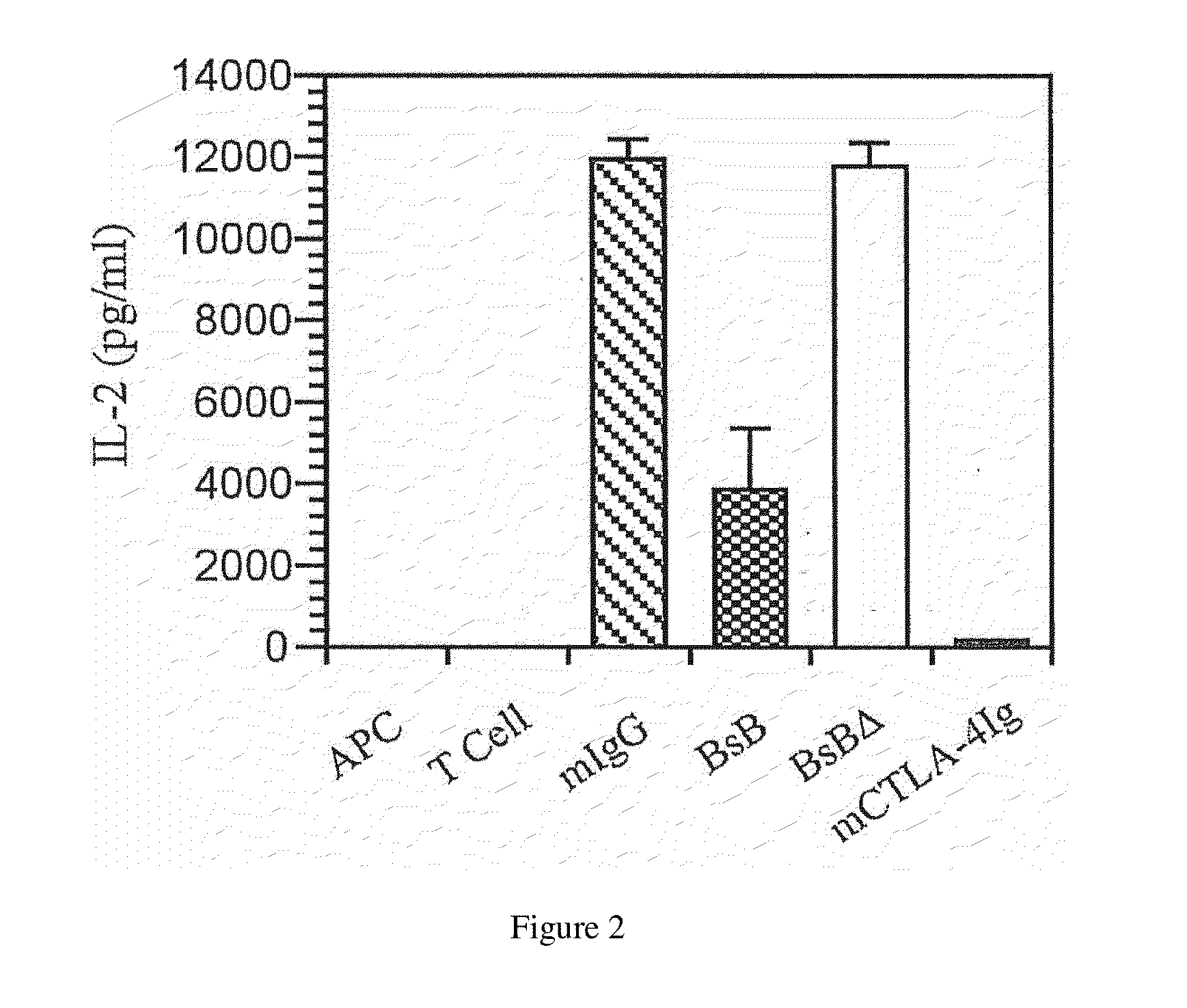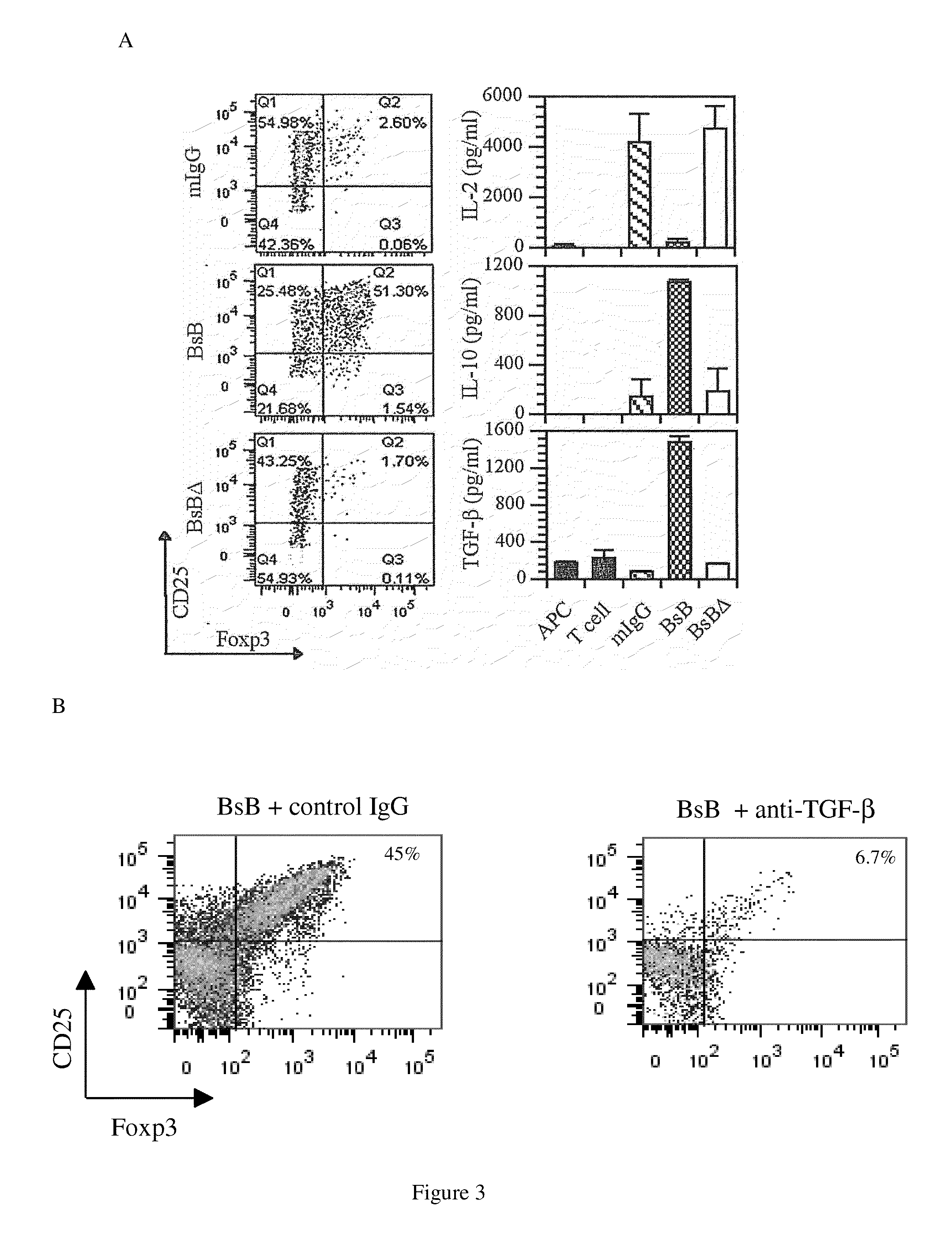Inhibitors of t-cell activation
a technology of t-cell activation and inhibitors, which is applied in the direction of peptide/protein ingredients, depsipeptides, fusion polypeptides, etc., can solve the problems of reducing the incidence of animals with diabetes, and achieve the effect of stimulating anti-inflammatory cytokines il-10 and inhibiting t-cell activation
- Summary
- Abstract
- Description
- Claims
- Application Information
AI Technical Summary
Benefits of technology
Problems solved by technology
Method used
Image
Examples
example 1
Design of a Bispecific Fusion Protein that Engages CTLA-4 and Crosslinks it to the TCR Via MHC 11
[0137]To generate a bispecific fusion protein that selectively and agonistically engages CTLA-4 and simultaneously ligates it to the TCR, mutant CD80 (CD80w88a, referred to hereafter as CD80wa) that binds CTLA-4 but has minimal affinity for CD28 (Wu et al., 1997) was fused to LAG-3, a natural ligand of MHCII (Baixeras et al., 1992; Triebel et al., 1990). CD80wa was joined to LAG-3 using a linker composed of nine glycines, which in turn was attached to the Fc portion of mouse IgG2a to purportedly increase its circulating half-life (FIG. 1A). In response to a ligand of this configuration, CTLA-4 engagement and ligation to the TCR were expected to occur indirectly, via formation of the tri-molecular complex (CTLA-4 / MHCII / TTCR) in the immune synapses during early T cell activation (FIG. 1B). Conceptually, outside of the context of the immune synapse, binding of the bispecific fusion protein ...
example 2
BsB Inhibits T Cell Activation in an Allogenic Mixed Lymphocyte Reaction
[0139]The relative ability of BsB and BsBΔ to inhibit T cell activation was assessed in an allogenic mixed lymphocyte reaction by measuring the production of IL-2. Naïve CD4+CD25− CD62LhighCD44low T cells that had been purified from BALB / c mice were mixed with APCs isolated from C57BL / 6 mice in the presence or absence of the BsB or BsBΔ. Murine IgG2a and CTLA-4Ig, a co-stimulation inhibitor that binds to CD80 / 86 and blocks their binding to CD28, were included as negative and positive controls, respectively. Inclusion of BsB but not BsBΔ in the mixed lymphocyte reaction inhibited IL-2 production albeit not to the same extent as that achieved by CTLA-4Ig (FIG. 2). This difference was likely the result of BsB-mediated T cell inhibition occurring later than CTLA-4Ig-mediated inhibition. More specifically, for BsB, inhibition only occurred after CTLA-4 was upregulated following T cell activation. The inability of BsB...
example 3
BsB Directs T Cell Differentiation into Tregs
[0140]Early termination of TCR signaling by withdrawal of antigen stimulation, inhibition of mTOR signaling, suboptimal TCR stimulation due to a low affinity antigen, or weak co-stimulation during T cell activation have been shown to induce Foxp3+ expression and skew T cell differentiation toward a Treg phenotype (Delgoffe et al., (2009) Immunity 30:832-844; Haxhinasto et al., (2008) J. Exp. Med. 205:565-574; Sauer et al., (2008) Proc. Natl. Acad. Sci. USA 105:7797-7802). As BsB forces early engagement of the TCR by activation-induced CTLA-4 with consequent attenuation of TCR signaling, its ability to generate Foxp3+ Tregs was also evaluated. Naïve CD4+CD62LhighGFP″ T cells prepared from Foxp3-EGFP knock-in mice (Haribhai et al., (2007) J. Immunol. 178:2961-2972) were mixed with LPS-treated allogenic APCs in the presence of BsB or BsBΔ. Flow cytometry analysis of the cells after five days of culture revealed a large number of CD4+CD25+GFP...
PUM
| Property | Measurement | Unit |
|---|---|---|
| weight | aaaaa | aaaaa |
| weight | aaaaa | aaaaa |
| pH | aaaaa | aaaaa |
Abstract
Description
Claims
Application Information
 Login to View More
Login to View More - R&D
- Intellectual Property
- Life Sciences
- Materials
- Tech Scout
- Unparalleled Data Quality
- Higher Quality Content
- 60% Fewer Hallucinations
Browse by: Latest US Patents, China's latest patents, Technical Efficacy Thesaurus, Application Domain, Technology Topic, Popular Technical Reports.
© 2025 PatSnap. All rights reserved.Legal|Privacy policy|Modern Slavery Act Transparency Statement|Sitemap|About US| Contact US: help@patsnap.com



